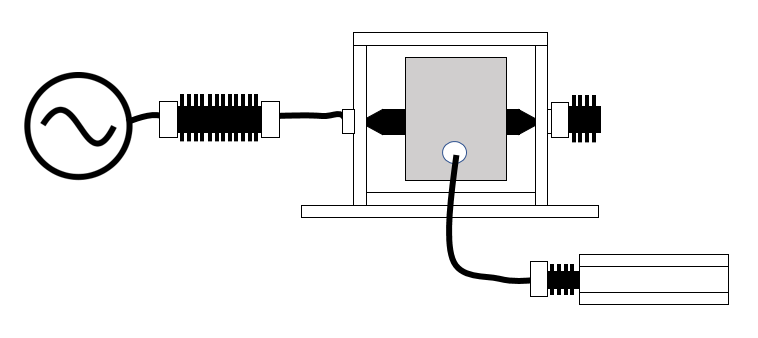RadiMation Application Note 104: Difference between revisions
| Line 24: | Line 24: | ||
After the absolute difference between the signal generator and powermeter is defined, the real transfer loss of the current sensor can be determined. Therefor we have to perform the Attenuation/Gain EUT calibration as described in [[Chapter_12#EUT_Attenuation_Calibration | Chapter 12]] of the manual. | After the absolute difference between the signal generator and powermeter is defined, the real transfer loss of the current sensor can be determined. Therefor we have to perform the Attenuation/Gain EUT calibration as described in [[Chapter_12#EUT_Attenuation_Calibration | Chapter 12]] of the manual. | ||
The measurement setup that should be used | The measurement setup that should be used, is now changed to have an 50 {{Ohm}} load on the other side of the calibration jig, and also to have the current sensor now mounted in the calibration jig, where the powermeter is connected to the current sensor. | ||
[[File:CurrentSensorCalibrationEUTCalibration.png]] | [[File:CurrentSensorCalibrationEUTCalibration.png]] | ||
Latest revision as of 21:37, 29 January 2019
How to determine the transfer impedance of a current sensor[edit]
The transfer impedance of a current sensor is important and required to perform accurate current measurements. A typical current sensor transfer impedance can be retrieved form the manufacturer of the current sensor, or it can be determined in a calibration laboratory. It is however also possible to determine the transfer impedance of a current sensor yourself, if you have the correct equipment.
This Application Note explains how measurements can be done in RadiMation® to determine the transfer impedance of a current sensor. These measurements are done by using the Attenuation/Gain calibrations as they are provided by RadiMation®. After the Attenuation/Gain calibration is performed, some calculations are needed to determine the correct transfer impedance, however these can easily be done in Microsoft Excel. A verification of the calibration and recalculation of the data can be done to ensure that the expected current is indeed correctly measured by RadiMation®.
The equipment that is required for this measurement is:
- Signal generator
- Attenuator
- Calibration jig which is suitable for the to be calibrated current sensor
- Power meter, or a spectrum analyser that is used as a power meter.
- 50 Ω load
- Current sensor
Performing the Attenuation/Gain system calibration[edit]
First we need to determine the absolute difference between the signal generator and the power meter, before we can measure the transfer loss of the current sensor. Therefor we first have to perform the Attenuation/Gain system calibration as described in Chapter 12 of the manual.
To ensure a higher accuracy it is advised to also include an attenuator and the calibration jig in the system calibration to arrange that the system calibration is very similar to the following EUT calibration. The attenuator is advised to be used to reduce mismatches between the signal generator and the calibration jig.
The measurement setup that should be used for this is:
Performing the Attenuation/Gain EUT calibration[edit]
After the absolute difference between the signal generator and powermeter is defined, the real transfer loss of the current sensor can be determined. Therefor we have to perform the Attenuation/Gain EUT calibration as described in Chapter 12 of the manual.
The measurement setup that should be used, is now changed to have an 50 Ω load on the other side of the calibration jig, and also to have the current sensor now mounted in the calibration jig, where the powermeter is connected to the current sensor.
Converting the measured data to a transfer impedance[edit]
During the Attenuation/Gain EUT calibration, the transfer loss of the current sensor is determined, where the input power (generated by the signal generator) is compared to output power of the current sensor (that is measured with the power meter). This difference is expressed as a positive attenuation value, which represents the 'loss' of the power.
The formula of the transfer impedance is:
is often expressed in dBΩ. Which corresponds to:
The is equal to the positive gain of a signal that is amplified by a system. In our situation we however already have determined the positive attenuation of the transfer loss. Because the difference between the gain and the attenuation is the sign of the value, the formula now becomes:
To calculate the transfer impedance of the current sensor, one has to copy the EUT Attenuation data result to Microsoft Excel, invert the sign and add 33.979. The calculate result is then the transfer impedance in dBΩ.
In RadiMation® create a new Correction file, and select the Frequency and Resistance columns. It is also important to select the correct unit for the Resistance column, which should be dBΩ in our situation.
The calculated result can then be copied from Excel to clipboard and pasted in the created Correction file in RadiMation®.
Specifying the transfer impedance for the current sensor device driver[edit]
Verification[edit]
After the transfer impedance of the current sensor is determined and attached, it is also possible to verify if RadiMation® is able to measure the expected current. The same setup as during the Attenuation/Gain EUT calibration can be used:
Relevant links[edit]
External pages that describe this same procedure in more detail are:


![{\displaystyle Z{t}[\Omega ]={\frac {V{p}}{I}}={\frac {V{p}}{\frac {V{in}}{50\Omega }}}={\frac {V{p}}{V{in}}}50\Omega }](https://wikimedia.org/api/rest_v1/media/math/render/svg/8b8701604249c014ec9a99b66bb55d6296282c9d)

![{\displaystyle 20log(Z{t})[dB\Omega ]=20log({\frac {V{p}}{I}})=20log(V{p})-20log(I)=20log(V{p})-20log({\frac {V{in}}{50\Omega }})=20log(V{p})-20log(V{in})+20log(50\Omega )}](https://wikimedia.org/api/rest_v1/media/math/render/svg/a93806a7557639c7f561220a8063394d84f1f5bc)

![{\displaystyle 20log(Z{t})[dB\Omega ]=-1*Attenuation+20log(50\Omega )=-1*Attenuation+33.979}](https://wikimedia.org/api/rest_v1/media/math/render/svg/9ca947d2a1e37c9b452d85235e831bc72bbde8c4)